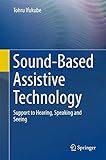Sound-Based Assistive Technology [electronic resource] : Support to Hearing, Speaking and Seeing / by Tohru Ifukube.
By: Ifukube, Tohru [author.] .
.
Contributor(s): SpringerLink (Online service) .
.
Material type:  BookPublisher: Cham : Springer International Publishing : Imprint: Springer, 2017Edition: 1st ed. 2017.Description: XII, 239 p. 196 illus., 11 illus. in color. online resource.Content type: text Media type: computer Carrier type: online resourceISBN: 9783319479972.Subject(s): Signal processing
BookPublisher: Cham : Springer International Publishing : Imprint: Springer, 2017Edition: 1st ed. 2017.Description: XII, 239 p. 196 illus., 11 illus. in color. online resource.Content type: text Media type: computer Carrier type: online resourceISBN: 9783319479972.Subject(s): Signal processingBasis for Sound-Based Assistive Technology -- Sound Signal Processing for Auditory Aids -- Functional Electrical Stimulation to Auditory Nerves -- Tactile Stimulation Methods for the Deaf and/or Blind -- Speech Recognition Systems for the Hearing Impaired and the Elderly -- Assistive Tool Design for Speech Production Disorders -- Sound Information Aiding for the Visually Impaired.
This book "Sound-based Assistive Technology" explains a technology to help speech-, hearing- and sight-impaired people. They might benefit in some way from an enhancement in their ability to recognize and produce speech or to detect sounds in their surroundings. Additionally, it is considered how sound-based assistive technology might be applied to the areas of speech recognition, speech synthesis, environmental recognition, virtual reality and robots. It is the primary focus of this book to provide an understanding of both the methodology and basic concepts of assistive technology rather than listing the variety of assistive devices developed in Japan or other countries. Although this book presents a number of different topics, they are sufficiently independent from one another that the reader may begin at any chapter without experiencing confusion. It should be acknowledged that much of the research quoted in this book was conducted in the author's laboratories both at Hokkaido University and the University of Tokyo. This book offers the reader a better understanding of the number of unsolved problems that still persist in the field of sound-based assistive technology.


There are no comments for this item.